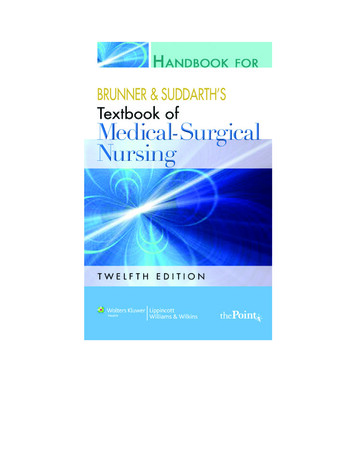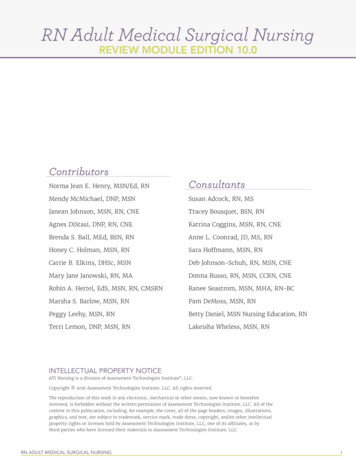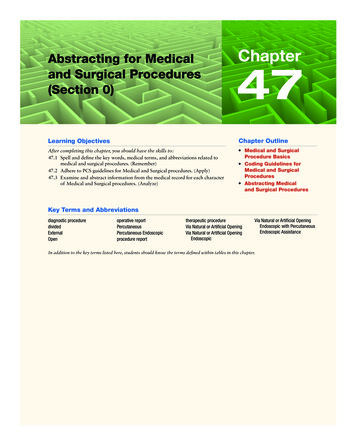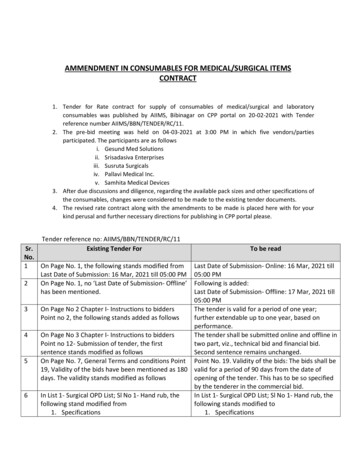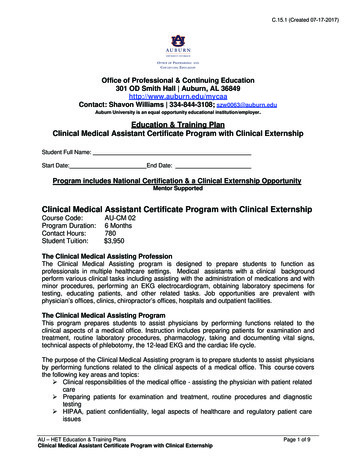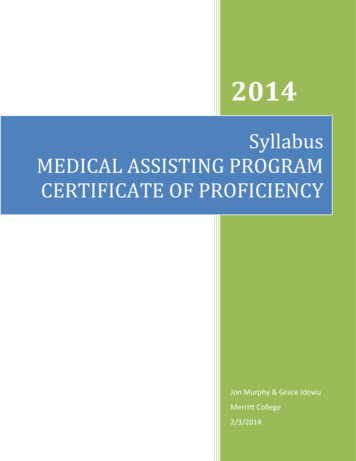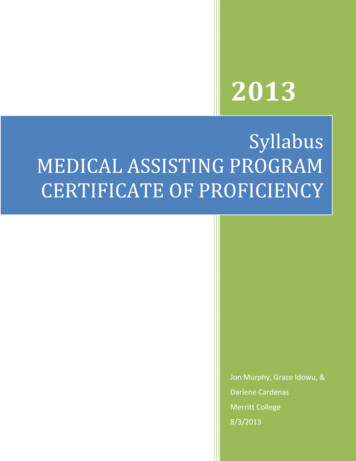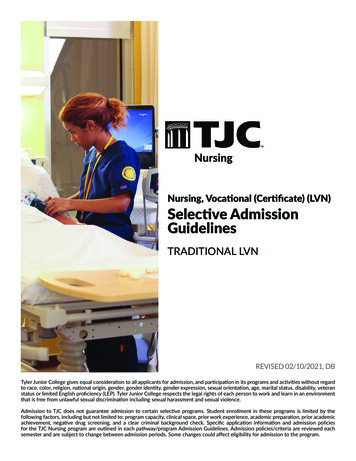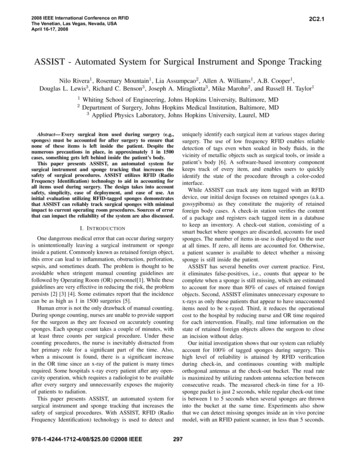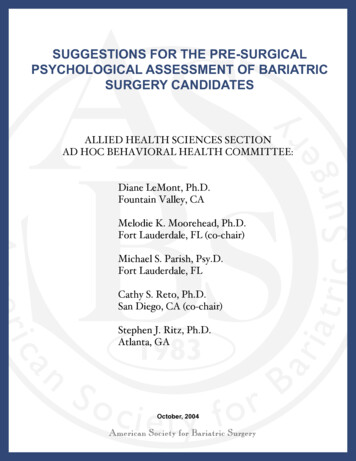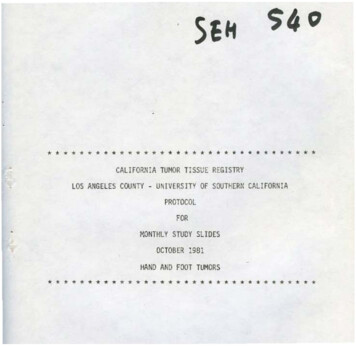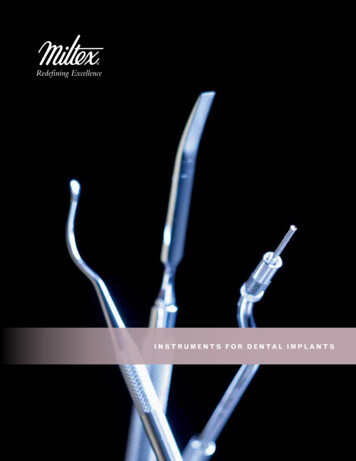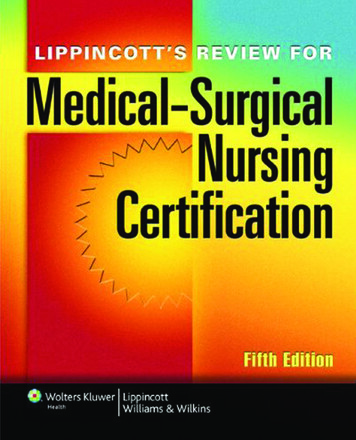
Transcription
LWBK942-FM.qxd6/25/118:45 AMPage x
Med-Surg FM.indd i8/17/2011 3:29:56 PM
STAFFPublisherJ. Christopher BurghardtAcquisitions EditorBill LamsbackClinical DirectorJoan Robinson, RN, MSNClinical Project ManagerBeverly Ann Tscheschlog, RN, MSClinical EditorMarian Pottage, RN, MSNProduct DirectorDavid MoreauThe clinical treatments described and recommended in this publicationare based on research and consultation with nursing, medical, andlegal authorities. To the best of our knowledge, these procedures reflectcurrently accepted practice. Nevertheless, they can’t be consideredabsolute and universal recommendations. For individual applications,all recommendations must be considered in light of the patient’s clinical condition and, before administration of new or infrequently useddrugs, in light of the latest package insert information. The authors andpublisher disclaim any responsibility for any adverse effects resultingfrom the suggested procedures, from any undetected errors, or fromthe reader’s misunderstanding of the text. 2012 by Lippincott Williams & Wilkins. All rights reserved. Thisbook is protected by copyright. No part of it may be reproduced, storedin a retrieval system, or transmitted, in any form or by any means—electronic, mechanical, photocopy, recording, or otherwise—withoutprior written permission of the publisher, except for brief quotationsembodied in critical articles and reviews and testing and evaluation materials provided by publisher to instructors whose schoolshave adopted its accompanying textbook. For information, writeLippincott Williams & Wilkins, 323 Norristown Road, Suite 200,Ambler, PA 19002-2756.Senior Product ManagerDiane LabusPrinted in China.EditorMSNCert5-011111Margaret EckmanCopy EditorsLeslie Dworkin, Erika KorsEditorial AssistantsKaren J. Kirk, Jeri O’Shea, Linda K. RuhfArt DirectorElaine KasmerDesign AssistantKate ZulakVendor ManagerCynthia RudySenior Manufacturing CoordinatorBeth WelshProduction ServicesSPi GlobalMed-Surg FM.indd iiLibrary of Congress Cataloging-in-Publication DataLippincott’s review for medical-surgical nursing certification.— 5th ed.p. ; cm.Review for medical-surgical nursing certificationRev. ed. of: Springhouse review for medical-surgicalnursing certification. 4th ed. c2007.Includes bibliographical references and index.ISBN 978-1-4511-1657-11. Nursing—Examinations, questions, etc. 2. Surgicalnursing—Examinations, questions, etc. I. Springhouse reviewfor medical-surgical nursing certification. II. Title: Review formedical-surgical nursing certification.[DNLM: 1. Nursing—Examination Questions. 2. Nursing—Outlines. 3. Certification—Examination Questions. 4. Certification—Outlines. 5. Perioperative Nursing—ExaminationQuestions. 6. Perioperative Nursing—Outlines. WY 18.2]RT55.A47 2012610.73076—dc2320110276448/17/2011 3:29:57 PM
ContentsContributors and consultantsForewordChapter 1Medical-surgical nursing certificationChapter 2Foundations of nursingChapter 3Legal and ethical aspects of nursingChapter 4Principles of medical-surgical nursingChapter 5Principles of wound careChapter 6Disruptions in homeostasisChapter 7Cardiovascular disordersChapter 8Hematologic disordersChapter 9Respiratory disordersChapter 10Neurologic disordersChapter 11Musculoskeletal disordersChapter 12Gastrointestinal disordersChapter 13Skin disordersChapter 14Endocrine disordersChapter 15Renal and urinary tract disordersChapter 16Reproductive system disordersChapter 17Immune system disordersChapter 18Eye, ear, and nose disordersChapter 19Perioperative nursingNANDA-I taxonomy II by domainNursing implications of diagnostic testsNursing implications in oncology careNursing implications in clinical pharmacologyCommon infectious disordersCDC hand hygiene guidelines fact sheetCDC isolation precautionsGuide to laboratory test resultsPosttestSelected iiMed-Surg FM.indd iii8/17/2011 3:29:57 PM
Contributors and consultantsKatherine Balkema, RN, BA, BSN, MM, RRT, CMSRNElisa Mangosing-Lemmon, RN, MSN, CMSRNClinical Nurse EducatorHolland HospitalHolland, Mich.Nursing InstructorRiverside School of Professional NursingNewport News, Va.Kaye L. Claytor, PhD, CMSRN, ACNS-BCJohn Allan Menez, RN-BC, MS, CMSRNEducation SpecialistClarian HealthIndianapolis, Ind.FacultyUniversity of PhoenixPhoenix, Ariz.Kim Clevenger, RN, MSN, EdDc, BCD. Angela Nguyen, RN, BSN, CMSNAssociate Professor of NursingMorehead State UniversityMorehead, Ky.Nurse EducatorScripps Mercy HospitalSan Diego, Calif.Kathleen Conn, RN, MSNJoyce W. Pompey, RN,C, BSN, MSN, DNP, APRN-BCNurse EducatorStevens-Henager CollegeMurray, UtahMedical-Surgical and Psychiatric NurseDuke University Health SystemDurham Regional HospitalDurham, N.C.Assistant ProfessorUniversity of South Carolina AikenSchool of NursingAiken, S.C.Marian W. Pottage, RN, MSIndependent Clinical EditorPaoli, Pa.Sharon Conner, RN, MSN, CMSRNMonica Narvaez Ramirez, RN, MSNClinical Education ConsultantINTEGRIS HealthOklahoma City, Okla.Nursing InstructorUniversity of the Incarnate Word School of Nursing & HealthProfessionsSan Antonio, Tex.Iris K. Freisner, RN-BC, BSNAssistant InstructorMt. Carmel College of NursingColumbus, OhioMaria Elsa Rodriguez, RN, MSN-CNS, CMSRNAssistant Professor of NursingSan Diego City CollegeSan Diego, Calif.Anna Jarrett, PhD, ACNS/ACNP, BCOrthopedic Advanced Practice NurseCentral Arkansas Veterans Health SystemsLittle Rock, Ark.Michelle Rudolph, RN, CMSRNRegistered NurseUniversity of Colorado HospitalAurora, Colo.Grace G. Lewis, RN, MS, ACNS-BCAssociate ProfessorGeorgia Baptist College of Nursing of Mercer UniversityAtlanta, Ga.Denise Verosky, MSN, ACNS-BC, CMSRNDirector, Palliative CareUPMC Mercy HospitalPittsburgh, Pa.Phyllis Magaletto, RN, MS, BCInstructor, Medical-Surgical NursingCochran School of NursingYonkers, N.Y.Tonya L. Willingham, RN, BSN, MANursing FacultyWatts School of NursingDurham, N.C.ivMed-Surg FM.indd iv8/17/2011 3:29:58 PM
ForewordMedical-surgical nursing is alive and well! Once considered a basic skill required ofall nurses, medical-surgical nursing has become increasingly complex, evolving intoa vital specialty nursing practice. Medical-surgical nurses must care for a growingnumber of health care consumers with complex medical needs as well as keep currentwith continuing developments in health care science, technology, and economics. Theymust overcome the challenges these developments can bring to providing patient carewhile continuing to provide high-quality nursing care to diverse patient populations inall stages of life—from adolescents to the elderly.Specialty certification is the most important step a registered nurse can take in his orher career. It signifies a nurse’s commitment to professional growth and developmentand, most importantly, to provide safe, effective, timely, and high-quality patient care.Research by the American Board of Nursing Specialties confirms that certification validates specialized knowledge, enhances professional credibility and autonomy, indicates professional growth, and provides evidence of professional commitment.Lippincott’s Review for Medical-Surgical Nursing Certification will certainly help youin your pursuit of certification as a medical-surgical nurse. This thoroughly updatedreview book offers the most current content typically included in medical-surgicalnursing certification tests by both the Medical-Surgical Nursing Certification Board(MSNCB) of the Academy of Medical Surgical Nurses (AMSN) and the AmericanNurses Credentialing Center (ANCC).The core content of this new edition has been attentively revised to reflect the bestavailable practices that influence medical-surgical nursing. It includes review topics onthe foundations of nursing, legal and ethical aspects of nursing, principles of medicalsurgical nursing and wound care, and disruptions in homeostasis. It also reviews thedifferent body systems and associated diseases that certification exams frequentlycover—and that medical-surgical nurses commonly encounter.New content includes cultural and ethnic beliefs and practices, evidence-basedpractice, safety issues, health maintenance and wellness, and lifestyle management.The many new topics covered include collaboration, patient’s bill of rights and selfdetermination, the developmental theories of Jean Piaget and Abraham Maslow, nutrition, substance abuse, abuse and neglect, complementary therapies, obesity, herbalremedies, adult immunizations, and laboratory values. Another highlight is the addition of more practice questions with rationales at the end of each chapter. The posttestat the end of the book has also been greatly expanded to ensure your mastery of thecontent you’ve covered.Whether you’re a newly graduated nurse exploring the specialty of medicalsurgical nursing, a displaced nurse reentering the nursing profession, or a seasonednurse wanting to update your skills and knowledge in medical-surgical nursing orbecome certified in this prestigious specialty, I know you’ll find this book a valuablevMed-Surg FM.indd v8/17/2011 3:29:58 PM
vi Forewordaddition to your library. More importantly, this book will give you the knowledge andconfidence you need to ace the medical-surgical nursing certification exam.I wish you well as you move forward in this major endeavor–becoming certified asa medical-surgical nurse.John Allan Menez, RN-BC, MS, CMSRNFaculty, University of Phoenix, Phoenix, Ariz.Adjunct Clinical Instructor, St. Catherine University, St. Paul, Minn.Medical-Surgical Nurse, St. Joseph Hospital, St. Paul, Minn.University of Minnesota Medical Center-Fairview, Minneapolis, Minn.Med-Surg FM.indd vi8/17/2011 3:29:58 PM
1Medical-surgical nursingcertificationMedical-surgical nurses are the backbone of health and wellness care in the United States. Indeed, new nursing graduates are strongly encouraged to work in a hospital as a medical-surgical nurse for 1 to 2 years tohone their skills before branching out into other areas of nursing. In 1972, the American Nurses Association(ANA) recognized this valuable specialty by certifying medical-surgical nurses through the American NursesCredentialing Center (ANCC)—almost 151,000 nurses have been certified to date in more than 30 specialtyand advanced practice areas of nursing. Further, as of 1990, a new medical-surgical nursing organization, theAcademy of Medical-Surgical Nurses (AMSN), was founded to serve the specific educational needs of thisgroup of nurses. The AMSN has also developed a certification examination to recognize the knowledge baseof the practicing medical-surgical nurse.The ANCC certification examinationThe ANA offers two examinations for medical-surgical nursing certification: a basic medical-surgical nurseexamination and a clinical specialist examination in adult health (formerly medical-surgical nursing). TheANCC administers the computer-based examinations in cities throughout the United States and its territories.The tests last about 4 hours.Eligibility and applicationThe ANCC establishes criteria for eligibility to take the examination. Requirements for the basic examinationdiffer from those of the clinical specialist examination. The criteria discussed in this book were in effect as ofthe 2010 examination. Because requirements can change, candidates should obtain the latest criteria beforeapplying for certification. (See ANCC certification eligibility requirements, page 2.) The medical-surgical nursingexamination is available to nurses with an associate’s degree or diploma, thus establishing two levels of credentialing. Nurses certified at the baccalaureate level are designated as Board Certified, or “RN-BC”; nursescertified at the associate or diploma level are designated as Certified, or “RN-C.” The credential approved forclinical nurse specialists is “APRN-BC.”After you have decided to prepare for the examination, obtain the certification catalog by writing to theAmerican Nurses Credentialing Center, 8515 Georgia Ave., Suite 400, Silver Spring, MD 20910-3492, or bycalling toll-free 1-800-284-2378. This catalog provides all the information you’ll need to apply. Examination information, catalogs, and applications may also be obtained through the ANCC Web site at www.nursecredentialing.org.Pay careful attention to all steps in the application process. Failure to complete any step correctly maymake you ineligible to take the examination on the date you had planned. All applicants must pay a nonrefundable application fee and an examination fee, set each year by the credentialing center.1Med-Surg Chap01.indd 18/2/2011 2:32:56 PM
2 Medical-surgical nursing certificationANCC certification eligibility requirementsThe American Nurses Credentialing Center’s (ANCC) eligibility criteria for certification in medical-surgical nursing, as of 2010,are listed below. Note that the requirements for the basic nursing examination differ from those of the specialist examination.Criteria for a medical-surgical nurse (RN-BC:Registered Nurse–Board Certified)By the time of application, you must:1. hold a current, active unrestricted professional registerednurse (RN) license in the United States or its territories orthe professional, legally recognized equivalent in anothercountry2. have practiced the equivalent of 2 years full-time as an RN3. have practiced as a licensed RN in medical-surgicalnursing for a minimum of 2,000 hours within the past 3years4. have received 30 contact hours within the last 3 years inmedical-surgical nursing.Criteria for a clinical nurse specialist in adulthealth (ACNS-BC: Adult Health Clinical NurseSpecialist–Board Certified)By the time of application, you must:1. hold a current, active RN license in the United States or itsterritories or the professional, legally recognized equivalentin another country2. hold a master’s degree or higher in nursing3. have been prepared in medical-surgical nursing through amaster’s degree program or a formal postgraduate master’sprogram in nursing4. have graduated from an accredited institution grantinggraduate-level academic credit for all of the coursework (including advanced health assessment, advancedpharmacology, and advanced pathophysiology) that includesboth didactic and clinical components, and a minimum of 500hours of supervised clinical practice in medical-surgical nursing.Source: American Nurses Credentialing Center, Silver Spring, MD.Available at www.nursecredentialing.org.Certification test planAfter establishing your eligibility, the credentialing center will mail you a handbook that contains the currentexamination blueprint, or test plan. The test plan outlines the test content and the ratio (weighting) of eachcontent area. Information about the test plan, especially its content, can provide considerable guidance inhelping you organize your study plan.In the ANCC catalog for 2010, medical-surgical examination topics included biophysical and psychosocialconcepts, pathophysiology of body systems, patient care, health promotion and wellness, management andleadership, and legal and ethical issues and trends. Examination topics for the clinical specialist in medicalsurgical nursing included clinical practice, consultation, management, education, research, and issues andtrends.The Board on Certification for Medical-Surgical Nursing Practice, one of the many ANCC certificationboards, develops the certification examination. The test objectively evaluates knowledge, comprehension, andapplication of medical-surgical nursing theory and practice to patient care. The test development committeedefines the content areas covered in each test and the emphasis placed on each area.Certified medical-surgical nurses from around the country contribute questions for each examination. Thecommittee reviews each test item for accuracy, readability, and relevance to the test plan. Sample questionsapproved by the committee are compiled into an examination that will be used on the next test date. All computer-based examinations offer on-site testing results. The certificate and ANCC pin are mailed about 8 weeksafter successful completion of the examination.Each test contains 175 multiple-choice questions. Of those questions, 150 are scored questions and 25 arenonscored, pretest questions. The pretest questions aren’t distinguishable from the scored questions. A candidate’s score is based solely on the 150 scored questions. Candidates have 4 hours to complete the test. A breakusually is provided.Med-Surg Chap01.indd 28/2/2011 2:32:56 PM
Strategies for a successful certification examination 3If the candidate takes a paper-and-pencil exam instead of a computer exam, test results are mailed about 6to 8 weeks after the examination. No results are released early or over the telephone to protect the privacy ofcandidates.The AMSN certification examinationThe AMSN is a professional organization for nurses who practice medical-surgical/adult health care. Theorganization developed the Scope and Standards of Medical-Surgical Nursing Practice; it builds on theANA’s Standards of Clinical Practice and helps to establish the responsibilities of medical-surgical nurses inall types of health care settings.The AMSN founded the Medical-Surgical Nursing Certification Board (MSNCB) to promote and implement a certification examination for medical-surgical nurses. The tests are offered as computer-based exams,available throughout the year, or as paper-and-pencil exams, administered four times a year. The test lasts 4hours.Eligibility and applicationThe MSNCB establishes criteria for eligibility to take the examination. However, because requirements canchange, candidates should obtain the latest criteria before applying for certification. (See AMSN certification eligibility criteria, page 4.) The medical-surgical certification examination does not require a BSN degree.Nurses who are certified through this examination are designated as “RN-CMSRN.”MSNCB works with a testing center, the Center for Nursing Education. The certification catalog and examination application may be obtained by writing to MSNCB, East Holly Avenue, Box 56, Pitman, NJ 08071. Ordownload an application from the Web site www.amsn.org.Again, be sure to read all directions, and pay careful attention to all steps in the application process. Failure to complete the application properly may lead to ineligibility to take the examination.Certification test planIf the application is completed properly, an examination permit is mailed approximately 2 weeks before thetest. The permit will include the test center address and the time you should report to the center. You musthave the examination permit to be admitted to take the exam.The paper-and-pencil exam contains 175 questions, including 25 nonscored, pretest questions. The exammust be completed in 4 hours, and results are mailed approximately 8 weeks after the exam.The computer-based exam contains 150 scored questions, with no pretest questions. The test must be completed in 3 hours, and the results are available immediately after the exam is completed.Strategies for a successful certification examinationWhen you’re ready to take a medical-surgical nursing certification examination, you’ll need to learn aboutthe certification process. Certification is a way to validate your knowledge, skills, and abilities as a medicalsurgical nurse. The certification test is based on predetermined standards, so you should become certified inyour area of clinical expertise.Start by selecting the organization you want certification from. Next, research the requirements for certification. You can begin your research by typing “medical-surgical certification” into a search engine. SomeWeb sites you might want to look more closely at include: www.msncb.org and www.nursecredentialing.org.Certifying organizations provide a test content outline, test reference list, and sample tests with practice questions. They typically list review courses with locations and dates as well as test-taking strategy courses. If youmust choose only one course, select the review course. You can learn about successful test-taking strategies byreading further.Med-Surg Chap01.indd 38/2/2011 2:32:56 PM
4 Medical-surgical nursing certificationAMSN certification eligibility criteriaThe Academy of Medical-Surgical Nurses (AMSN) eligibility criteria, as of 2010, are listed below.By the time of application you must: hold a current and unrestricted license as a registered nurse (RN) in the United States, or any of its territoriesOR hold a current, full, unrestricted license to practice as a first-level nurse in the country in which one’s nursing educationwas completed; and meet the eligibility criteria for licensure as an RN in accordance with requirements of the Commissionof Graduates of Foreign Nursing Schools (CGFNS) have practiced a minimum of 2 full years as an RN in an adult medical-surgical clinical setting have accrued a minimum of 2,000 hours within the past 3 years of clinical practice in an adult medical-surgical setting.Source: Academy of Medical-Surgical Nurses, Pitman, NJ. Available at www.amsn.org.Three essential components lead to successful certification: following a well-thought-out study plan andreviewing diligently, preparing carefully for examination day to avoid unexpected surprises, and learningsuccessful test-taking strategies. Each component calls for a closer look.Following a study planSuccessful test preparation calls for a well-thought-out study plan. This book provides you with an organizedsource for that review; you can also use the test-center content outline to help guide your study plan. Thenidentify the concepts you find most difficult and content where you have a knowledge gap, and place thosetopics first on your study outline. Next, divide the study plan into weeks and then subdivide that into days.Divide the topics into study sessions for each day.To help organize your thoughts, make note cards that concisely cover major topics. Be creative with thenote cards. Use mnemonic devices to help you recall information you otherwise can’t easily remember. Trysome brightly colored pens or pencils to help make the cards decorative and visually memorable.Make sure you allow at least a week for each of the major content areas. Then divide each week into a pattern of study by days. Study a topic thoroughly on its assigned day of the week, and then reserve a day totake practice exams, using good test-taking strategies. Mark off each topic as you complete it.Use 2 of the last 3 days before the exam to review topics you’re still weak on and to take practice exams.When you take practice exams, also practice pacing yourself so that you’ll be able to complete the exam. Giveyourself about a minute to answer each question; use a stopwatch if necessary. Finally, reserve the day beforethe exam for rest and relaxation.You may want to try combining study with exercise. For instance, walking while studying can help you torelieve stress, relax, and maintain your physical health. Just remember, if you walk and study, be safe; don’twalk on busy streets or use equipment that could lead to an accident.Some certification centers offer the choice of taking the test using either paper and pencil or a computer.Make sure you take practice tests using the appropriate method. If you plan to take the test on a computer—the most popular method—then take online practice tests. If you plan to take a paper-and-pencil version ofthe test, take practice exams using that method.Most medical-surgical certification exams range from 3½ to 4 hours. The week before the exam, take a practice test that’s the same length as the actual exam, and spend the full 3½ to 4 hours taking the exam. Think ofthis as pre-examination calisthenics. If you have time, take a full-length exam twice, on separate days. However, don’t attempt a practice exam the day before the real exam; you’ll tire yourself out unnecessarily.Med-Surg Chap01.indd 48/2/2011 2:32:56 PM
Strategies for a successful certification examination 5After you’ve completed the study plan, use the last day for rest, relaxation, and final last-minute preparation for the test. Eat nutritiously, participate in light exercise, and get plenty of sleep the night before theexam.Preparing for examination dayCareful planning can help you avoid unexpected surprises on test day. Make sure you know the exact locationof the test center. Drive to the center a few days before the actual test at about the time the test is scheduled.Time the drive so you know how long it will take to arrive.Collect the required identification. Most test centers will accept a driver’s license, passport, or U.S. militaryidentification. Make sure your identification is current (not expired), and that your name and address are correct. Test centers may not allow books, calculators, food, drinks, notes, cell phones, or personal electronics;check the test center’s rules before you arrive. Also, check to see what is allowed. If the center allows pencilsand paper, make sure you bring them with you.The evening before the exam, fill your car’s gas tank, lay out your clothes, pack a small bag of peanut-covered chocolate (or another high-energy snack if you’re allergic to peanuts) and a bottle of water, and gathertogether your note cards. Plan to wear layered clothing, shoes with covered toes to prevent cold feet, and generally comfortable attire.On day of the test, arrive 30 minutes ahead of time. Before entering the test site, eat your snack; the peanuts will provide long-term energy, the sugar will give you quick energy, and the chocolate will make theneurons in your brain fire faster. Then drink enough water to quench your thirst. Next, pull out your notecards one last time and look at them. Don’t analyze them or attempt to learn anything in the last minute; justtry to see what each card looks like.When you arrive at the center, you’ll be checked in to the test site and then admitted to the examinationroom. Before you enter, take one last bathroom stop. Once you’re in the examination room, at the start of thetest write down everything you can still “see” from your note cards (if you’re allowed to have paper and pencil in the examination room). Write down everything you can visualize, but don’t spend more than 10 minutes transcribing note cards from memory.Finally, remember that you’ve studied hard, learned extensively from clinical practice, and prepared wellto take the medical-surgical nursing certification examination. Have confidence in yourself; you’re ready forthe test!Learning test-taking strategiesYou can improve your chances of passing any standardized multiple-choice examination by using proventest-taking techniques. These include knowing how timed examinations are administered, understandingall the parts of a test question, and taking specific steps to help make sure that you’ve selected the correctanswer. And if you come across a question you absolutely don’t know the answer to, you need to know howto make a good guess!Because you aren’t penalized for guessing, you should try to respond to every question. Answeringother questions may stimulate your recall of the correct answer for a question you’ve left unanswered. Ifyou still have no idea of a correct answer, certain tricks can give you a greater than 50% chance of guessingaccurately.Keep in mind that the people writing questions for certification exams are experts in the content area andknow test-taking strategies thoroughly, so the following tricks may not always work for you. But generally,you’re more likely to guess correctly if you select option B or C. Also, longer answers tend to be correct, andif you come across two similar answers, one of those answers is probably correct. Eliminating at least oneanswer that you’re sure is incorrect will also improve your chances of guessing correctly. And, if all otherstrategies fail, you still have a one in four chance of guessing correctly.Med-Surg Chap01.indd 58/2/2011 2:32:56 PM
6 Medical-surgical nursing certificationTo try out your test-taking strategies, you can take online tests from other disciplines that you know nothing about. In such cases, all you have to rely on are good test-taking strategies. If you score at least 60% onsuch tests, you’ve mastered those strategies.All questions on a certification examination are carefully crafted and pretested to ensure readability anduniformity. Understanding the components of a question can help you analyze what it’s asking, increasingthe likelihood that you’ll respond correctly. (See Parts of a test question.)Time management is crucial when taking a standardized test because you receive no credit for unansweredquestions. Because of that, you should try to pace yourself to finish the test on time. Remember, you’ll haveabout a minute to answer each question. Don’t spend too much time on any one question. If you’re taking apaper-and-pencil exam, place a light pencil mark next to a question you’re unsure of and come back later, iftime is available.Computer-based exams also allow you to mark questions you’re unsure about to return to later if timepermits. Make sure you know how to mark questions before starting the test; the proctor can help you if youneed assistance.For both computer and paper-and-pencil tests, read every question carefully. If a clinical situation precedesthe question, study the information given. Watch for key words (such as most, first, best, and except); they’reimportant guides to which option you should select. For example, if a question reads, “Which of the following nursing actions should the nurse perform first?” you may find that all the options are appropriate for thepatient’s condition but only one clearly takes precedence over the others.As you read the stem, cover up the answers on a paper test or ignore the computer screen with
iii Contributors and consultants iv Foreword v Chapter 1 Medical-surgical nursing certification 1 Chapter 2 Foundations of nursing 8 Chapter 3 Legal and ethical aspects of nursing 23 Chapter 4 Principles of medical-surgical nursing 38 Chapter 5 Principles of wound care 51 Chapter 6 Disruption
